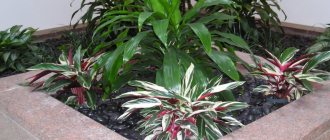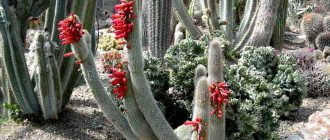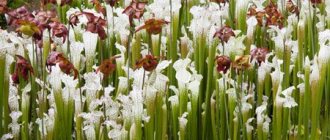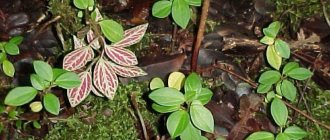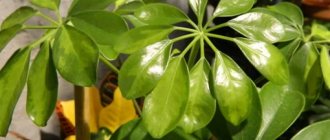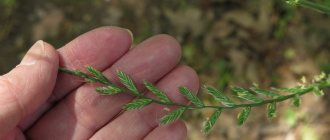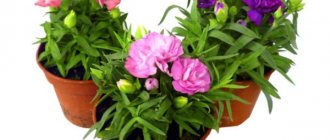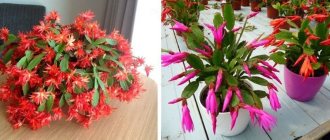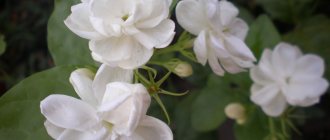It can rarely be found on the pages of encyclopedias, but more and more often it decorates wet flower beds in the gardens of exotic lovers.
One type of rush plant has taken root in indoor plant growing – Junkus effesus (spreading rush).
Types and varieties for home cultivation
Several species are grown for decorative purposes:
| View | Description |
| Creeping | Used for decorating aquariums and ponds. It can grow completely submerged in water; when grown under water, the leaves curl into rings. It is easy to care for and does not require additional feeding. Looks impressive against the background of large-leaved plants. |
| Filiform | Also bred for decorating ponds. Perennial, prone to self-seeding, therefore requires careful control of germination. Tolerates winter well. |
| Flattened | A perennial, also used in decorating the coastal zone. Tolerates winter well. |
| Sword-leaved | Originally from America, it was relatively recently transported to Russian territory. Winter-hardy spreading perennial about 40 cm high. |
| Toad | They are considered a weed species, but can also be used for decorating low-lying and wet areas. |
| Spreading | A distinctive feature is the stems, twisted in a spiral, completely devoid of leaves. Perhaps the most beloved member of the family by designers and gardeners. Perennial, stems about 5 mm in diameter. Four decorative forms of this species are common:
|
Description of the plant
The main distinguishing feature of juncus is its stems - extravagant, spiral-shaped. The shoots are delicate and long, completely without leaves. At home it grows up to half a meter.
Spiral stems and long shoots-twigs are special features of the rush plant. It grows in the form of a kind of hummock with thin leaves, at the tips of which small flowers occasionally appear. It is often confused with marsh weed. The most common species found at home is the spreading rush (Juncus effusus spiralis). It has no leaves, but has twisted stems.
The herbaceous perennial has greenish or brown unisexual inflorescences. One peduncle usually contains one flower and two bracts. The flowering period of the rush plant is no more than a day a year.
There are over 300 species and hybrids of juncus in the world.
Difficulties in home care
Despite the extravagance of the rush plant, it is quite unpretentious. Although, of course, it will require attention. The most important thing in breeding rush grass in an apartment is not to forget that this family, after all, comes from the banks and swamps, and accordingly, loves swampy soil and moisture.
Location, lighting
Lighting is of great importance, but direct sunlight is harmful and is usually poorly tolerated, so when choosing a location for placing a pot, it is advisable to choose the western and northern side. Since the plant does not tolerate any hint of wind very well, the windowsill is also an unsuitable place for it to live.
Many experts, when breeding spiralis (as rushnik is often called), initially accustom the plant to partial shade, in which case it will grow comfortably in the center of the room. This is what interior decorators often use to effectively zoning a space. This information can be clarified in advance at the stage of purchase at a flower shop.
Temperature
Despite the fact that most members of the genus tolerate frost well, in indoor conditions spiral juncus requires maintaining a constant air temperature from +16 to +24 degrees. When the temperature drops below +15 degrees, the plant goes into hibernation, its growth stops, and the stems begin to dry out. In some cases, especially if the plant is no longer young, experts advise giving the plant such periods of rest. But young juncus do not need rest.
Types of spreading rush
Watering, humidity
The main difficulty in caring for juncus is creating optimal air and soil humidity. This plant develops well in hydroponics; automatic watering is also acceptable.
Does not tolerate soil drainage; the water level in the pan must always be constant.
When watering, it is best to use well-settled water at room temperature. Very often on forums, experienced flower growers advise creating a personal “swamp”, although in this case there are a number of everyday disadvantages. In addition to the humidity level of the substrate, air humidity is no less important. When the indoor humidity is less than 50%, rush irrigation is required, but not directly on the plant, but slightly to the side, creating fog.
Fertilizer
Feeding is required only during the period of active growth (spring, early summer). Junkus loves universal and organic fertilizers, not too often, a couple of times a month is enough.
During the rest period, the rush plant does not need additives; it is also worth limiting watering.
Trimming
As a rule, this plant does not need pruning. The only exceptions are the stems that grow straight in spiralis and single-colored in gold strike. In this case, if pruning is not done in a timely manner, there is a risk of losing the decorative flavor of the plant, since there is a high probability that subsequent new stems will be the same.
Transplantation: choice of pot, soil
About once a year, before the stage of active growth, the rush plant needs to be transplanted. To be sure that this is really required, it is worth assessing the drainage holes of the pot: if the rhizome has sprouted into a thick, branchy brush, then it is time to select a larger pot and replant it.
Since this is a marshy plant, both paludariums and the most ordinary pots with large containers for liquid, or double ones, are perfect for it.
The diameter of the new pot should be approximately 5 cm larger than the previous one. Before the procedure itself, it is worth carefully assessing the condition of the rush plant: as with any other plant, the replanting is canceled if flowering occurs.
When removing a rush plant from an old pot, it is worth carefully inspecting its root system; if rotting is suspected, the damaged area is removed. Hydroponics is excellent for the plant, but can be replaced with any light, acidic substrate.
Reproduction
It is the moment of transplantation that is most successful for reproduction. Since this species reproduces only vegetatively, it is sufficient to divide the root system, provided there is a sufficient volume of rhizome and above-ground parts.
Usually, the rush plant tolerates this process very easily and after 7-10 days begins to actively grow again.
Swamp Star Indoor Career
Among indoor crops, there are many plants that are actively used in landscape design. But most of them still belong to the category of annuals or profusely flowering shrubs, but there are not so many decorative deciduous crops. And among them, literally on the fingers of one hand, you can count the exotic and extravagant plants - both in appearance, and in terms of growth form, and in terms of requirements for conditions. The rush plant, or juncus, belongs to just such selected plants.
This is a well-known inhabitant of ponds and one of the best picturesque plants for decorating water features and wet beds in the garden. Its status as a houseplant even today seems more like a mistake than a rule. But rush plants are so unique that one should not be surprised at the attention of designers and florists to this culture. In terms of graphics, only Sansevieria can compete with them, and even then, against its background, the rush plant seems just an “alien.”
Ruts, which are quite rightly called both juncus and juncus (Juncus), are representatives of the family of the same name (Juncaceae). They got their name from the use of shoots for weaving mats, baskets or shoes, known since the times of ancient empires (from the Latin “to weave”). These are perennial short-rhizome cereals, most of which are characterized by low winter hardiness and extreme moisture-loving properties. In indoor culture, juncus plants are limited to a height of 40 to 50 cm. At the base, thin, hard stems are dressed in scale-like sheaths of a brownish color, which do not spoil the impression of the turf.
Rushes are capable of flowering, like all cereals; when small flowers appear in inflorescences on the bizarre bushes, they still seem like an unearthly vision. Brownish or dirty whitish, they are collected in panicles with crowded asymmetrical branches, as if inclined to the side from the bract, which seems to be a continuation of the stem.
In indoor culture, unlike in garden culture, juncus plants cannot boast of an enviable variety. But the one species that can grow in pots is so unusual that it makes up for the lack of much choice. Only the spreading rush (Juncus effusus) is grown as a houseplant. And even then, most often we are talking about a single variety, which today has attracted everyone’s admiring attention with its thin leafless shoots twisted in a spiral.
Spreading rush "Spiralis" (Juncus effusus 'Spiralis'), which we like to call simply spiral rush, and is even sold in flower shops under this name, is an inimitable representative of cereal grasses, producing a thick but spreading turf of thin and very long stems without leaves. Juncus shoots are not straight, but intricately twisted in spirals, as if they were specially artificially wound by hand to obtain such an unusual shape.
Juncus effusus 'Spiralis', or Spiral Rusticum. © intratuin
But the representation of this marsh grass in indoor culture is not limited to the legendary spiral rush. Firstly, the 'Blonde Ambition' variety is very similar to it, only its spirals are straw-golden and with larger “coils”. Secondly, among the rush plants you can also find upright growing varieties, the decorativeness of which is in no way inferior to the legendary “Spiralis”:
- The juncus variety 'Aureostriata' has powerful, straight, variegated stems with alternating green and yellow areas.
- Juncus variety 'Pencil Grass' (Pencil Grass) - juncus with fairly thick straight shoots that form turf, most similar to green fagots of brushwood or reminiscent of giant grass. The hollow leaves are glossy dark green and grow in dense turf, reaching a height of more than half a meter.
- Juncus cultivar 'Golden Line' is a golden-colored cultivar that appears to be an artificial ornament and is striking in both the texture of its straight, thin, hollow branches and its overall elegance.
Sitniki are inimitable modern accents that can be used in the design of even the most daring and extravagant interior styles. They replace full-fledged large decor and sculptures. Juncus trees feel great not only in ordinary or living rooms, but also in bathrooms or greenhouses. These are one of the most beautiful “horizontal” space dividers that perfectly perform the function of zoning. And the visually graphic crown, consisting entirely of exquisite lines and “strokes,” creates inimitable optical illusions, expands the space and creates a feeling of “sliding” the walls.
Negative consequences of improper care
| Symptoms | Causes |
| The stems look pale. | Lack of lighting. |
| The shoots are drying up. | Insufficient air humidity or low room temperature (in this case, the plant is preparing for a period of hibernation). |
| The shoots dry (at normal humidity and temperature). | Possible rotting of the root system. As a rule, it occurs due to untimely transplantation. In this case, it is necessary to carefully examine the rhizome, remove damaged ones and replant with a complete replacement of the soil. |
| Whitening of leaves. | Juncus lacks air and nutrition; this usually happens if the substrate is compacted and the root system cannot fully nourish the plant. |
How to replant rush grass
How to replant juncus plant photo
The rush plant should be replanted as needed: when the container becomes small, the stems have thinned out significantly, an emergency replantation is required (the soil has become sour or rot has appeared). In general, it is advisable to replant annually in the spring. The plant tolerates the procedure well and recovers quickly even after a forced transplant. Be sure to inspect the root system for rot, remove the affected areas, and treat with a fungicide. For any transplant, the substrate is completely changed to a new one.
Often, rush grass is grown in a paludarium (a special tank with a semi-aquatic environment). An ordinary pot will do, but it must be quite narrow and high, since the root system grows deeper. When transplanting, the diameter of the new container should exceed the previous one by a couple of centimeters.
The soil required is loose, light, permeable, and acidic. Several options are suitable:
- Soil for aquatic plants;
- Hydroponics;
- An earth mixture based on garden soil with the addition of bog peat and moss;
- Take 2 parts of turf soil and 1 part each of leaf humus, peat and river sand.
At the bottom of the pot, lay a drainage layer consisting of coarse fraction components - pebbles, expanded clay, pieces of pumice.
After transplantation, the root collar should be at the same level. Mulch the soil surface with expanded clay or decorative pebbles, which will prevent rapid evaporation of moisture from the soil.
Diseases, pests
Sitnik is not susceptible to most diseases. Among the pests it can be affected by mites, scale insects and aphids. It is quite easy to detect an infestation.
- In case of spider mite infestation, the stems become covered with a light sticky web.
- Scale insects can be identified by the appearance of dark plaques and plaque on the plant.
- Aphids reproduce very quickly, so they are very noticeable on shoots: they are small green bugs.
Both folk remedies such as soap solution and professional insecticides are suitable for treatment. As a rule, one treatment is sufficient.
Reproduction
In the spring, when replanting, the juncus bush can be divided into divisions or new plants can be grown from seeds. For indoor floriculture, the first method is most often used.
Cuttings
Plant the seeds in a separate container as you would any other seeds. Water and cover the container with film to create a greenhouse effect. This will promote faster seed germination. The formed bushes will grow in this container until next year, when they need to be replanted.
By division
When dividing an earthen clod, it is necessary that each part of the bush has several divisions left. The cutting site is sprinkled with activated carbon. The delenki are planted in separate pots.
Did you know? One of the smallest and most unique juncus
—
Juncus pygmaeus. At the beginning of summer, its leaves acquire a very beautiful pink-violet hue.
Mr. Summer Resident informs: Sitnik according to Feng Shui, signs and superstitions, benefits and harms
In ancient China, they believed that rush plant branches given to newlyweds in their new home guaranteed a strong marriage for life and made family ties stronger. And from a scientific point of view, rush grass has a very beneficial effect on the microclimate of the room.
This plant not only loves humidity very much, but also well moisturizes and purifies the air in the room in which it is located.
But the most obvious thing is that you can’t help but admire this handsome man! This means positive emotions are guaranteed for Juncus owners.

